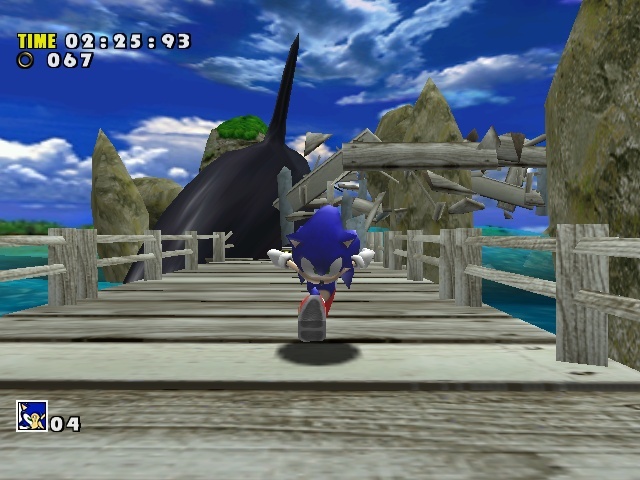Sonic Adventure (Dreamcast) Review
By Tomas Barry  18.07.2016
18.07.2016

After the ground breaking Super Mario 64, not to mention Crash Bandicoot making waves within the platforming genre, too, Sonic's transition into the third dimension had a lot riding on it. However, whether Sonic Adventure actually reaches the standards of his competitors in pure platforming terms is a difficult question to answer, especially retrospectively. For its contemporary audience, however, it certainly ticked all the boxes.
SEGA wanted something to showcase the Dreamcast's power as it had much more under the hood than its then competitors, the PS1 and N64. Sonic Team definitely did not disappoint in this respect. The graphical fidelity was impressive for its time, and the eye-watering speeds were a vital ingredient contributing toward the general sense of exhilaration. When gamers stumbled upon a Dreamcast kiosk in the late 90s, Sonic Adventure certainly left them impressed about what a new generation would offer.
That sentiment, however, could be the reason why the game hasn't really withstood the test of time particularly well. Boot up any version of Sonic Adventure today and those original sensations will be replaced with an unshakable sense of nostalgia that almost bridles it. It's perhaps difficult to recapture that initial 'wow' factor because the game also aimed to highlight an extensive range of new possibilities offered by the new system. In this sense, where earlier games in the series are highly focused on core mechanics, Sonic Adventure spreads itself out rather more broadly.

For example, Sonic Team introduced five other playable characters each with their own intertwining story-arc. This enabled a variety of different gameplay mechanics to be featured with each character. Sonic's emphasis was what you'd expect; Tails' chapters involve getting to a location before his friend; Knuckles' stages tasked the player with seeking out Master Emerald shards; Amy, equipped with a hammer, has to escape the pursuit of E-100 Zero; the infamous Big the Cat employs fishing to search for a befriended frog; and lastly, E-102 Gamma introduces shooting mechanics to the franchise for the first time. Back then, these gameplay variations were received fairly well. However, this aspect of Sonic Adventure is more likely to incur criticism today, as it dilutes the core gameplay mechanics fans know and love.
It's certainly true that the most successful moments of the game largely happen with Sonic himself, during the 'action stages.' Comparatively speaking, the other characters' levels all tend to feel like filler. Note that Sonic Generations didn't try to encapsulate anything about Adventure except the blue hedgehog's best moments, which illustrates this point. Somewhat bizarrely, though, when viewed through a retrospective lens, the most successful element of Sonic Adventure is arguably the birth of the Chaos.

Sonic could hatch 'Chaos' from eggs, from within three small-scale areas accessed within the 'adventure field' environments. The real killer feature from this was the ability to carry these creatures around on the go, via the Dreamcast's removable handheld VMU. This unique feature was heavily influenced by the highly popular gadget of the time, the Tamagotchi. Arguably, it was quite lightweight by comparison, but it did succeed in being both memorable and refreshing. Moreover, it was another great example of the kind of innovations that the system promised. The idea returned in greater depth with the more expansive Chao Garden in Sonic Adventure 2. It was so popular that for the DX version, Sonic Team preserved the same functionality by allowing a link to the GBA, via a copy of Sonic Advance and the connection cable.
Considering the range of content, the experience flows fairy nicely. It's initially jarring to hop from the fast-paced action with Sonic to, for example, searching out shards of emeralds with Knuckles. However, once all the introductions are over and done with, the various mechanics in play seem well arranged and appropriately counter-balanced by each other, somewhat compensating for their minimal depth. The highlights of Sonic Adventure are definitely its set-piece moments. These include being chased along a walkway by a whale, and snowboarding down a mountain during an avalanche. And as previously stated, they all happen with Sonic, whose story is roughly twice as long as any other.

Thankfully, the best of the game isn't inhibited too severely by the worst of it, even almost two decades later. Its most glaring issue is definitely the famously unhelpful camera, which is prone to plunging you off cliffs and being unpredictable in general. The fact this issue was mostly left unaddressed for the XBL and PSN releases underlines just how unworkable it was.
From a modern standpoint, the game's most obvious negative is how unashamedly drenched it is in nineties culture. Sonic's trademark electro-pop sound is replaced by electric guitar and cheesy, vague vocals, which don't work particularly well these days. Much in the same vein, the entire cast embarrass themselves when they speak, as the dialogue seems lazy and totally devoid of any real care and attention. For the most part, 'attitude' seems to replace any real sense of character.
This is true in a larger sense of Sonic Adventure's story, too, which is vague and fairly nonsensical. It seems certain that the 'the God of destruction' will be consigned to the abyss, never to be reintroduced to the Sonic canon. It is a great shame that the story couldn't have taken a backseat again, as in the original series. This is especially considering Sonic Team stuck quite rigidly to many of the formulas and ideas that were first laid out in this title.

Cubed3 Rating
Very Good - Bronze Award

With all of that said, Sonic Adventure is still, without a doubt, a real classic of its time. Although it seems to have shrunk in stature, as it grows old, for those who enjoyed the ride in the first place, this is well worth replaying for the nostalgia rush alone. The best-selling Dreamcast game has a place on the shelf of any Sonic fan, and any decent SEGA fan. It's a shame that Sonic Team never quite reached this level again, with the exception of its follow-up sequel, Sonic Adventure 2.

![]() 7/10
7/10
![]() 0
(0 Votes)
0
(0 Votes)
 Out now
Out now  Out now
Out now  Out now
Out now  Out now
Out now Comments
Comments are currently disabled

 Sign In
Sign In Game Details
Game Details Subscribe to this topic
Subscribe to this topic Features
Features






 Top
Top

